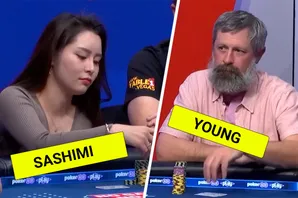Usually, when you play Texas Hold’em poker and several other poker variants, there’ll be a small blind and a big blind for each deal. The big blind is usually the value of one minimum bet, and the small blind is typically the value of half a minimum bet.
A straddle bet is another alternative blind that can be made before any cards are dealt. Normally twice the size of the big blind, a straddle in poker increases the stakes by increasing the size of the pot before players have even had a glimpse of their hole cards.
Straddling in poker is not something you’re allowed to do in poker tournaments. It’s typically reserved for cash games. We must stress that this is a 100% optional bet type. You could quite conceivably play poker for the rest of your life and never need to straddle, but if you didn’t even know a poker straddle bet existed, this article will put you in the picture of its pros and cons.
The most popular types of straddle in poker
If you’ve only ever played poker online, the chances are you’ll have never come across straddling in poker. It’s usually reserved for live cash games.
There are three popular types of poker straddle used. Below, we’ll explain how each of them works in case you’re faced with opponents who like to straddle during live poker sessions:
The under-the-gun (UTG) straddle
We’ll start with one of the most classic types of poker straddle, the UTG straddle. The player sat directly to the left of the big blind opts to place a straddle bet of twice the big blind. The pre-flop betting action then commences with the player to the left of the straddle. This means the straddler becomes the final player to act pre-flop.
If another player raises the pot, the action moves clockwise around the table as normal, all the way to the straddler. The onus is then on the straddler to decide whether to fold, call or raise again.
The size of an UTG straddle is usually twice the big blind, but each poker room reserves this decision. In some card rooms on the Las Vegas Strip, it has been known to set straddles at 25x the small blind. This may be to deter players from doing so or make it juicy for opponents who face regular straddlers.
The Mississippi straddle
The Mississippi straddle is most commonly used in high-stakes No Limit Hold’em and Pot Limit Omaha poker games. In this instance, the dealer button has first dibs on straddling at a cost of 2x the big blind. If the button opts not to straddle, it’s then opened up to the player to the dealer’s right. The process goes on until a player straddles or all players decline to straddle, and the hand plays out in normal fashion.
What’s great about a Mississippi straddle is that players can pay to take late position both pre and post-flop, unlike the classic UTG straddle, which only gives you position pre-flop.
The button straddle
Some people incorrectly believe the button straddle to be the Mississippi straddle – but it’s not. Some poker rooms will use the straddle rule, where the small and big blinds are initially skipped.
The action starts with UTG and if any of the players raise the straddle before it reaches the dealer button, the betting action moves around the table as normal. The button can then act before the betting finally moves round to the small blind.
Is straddling in poker generally a good idea or not?
In the main, whenever you choose to straddle at the poker tables, your expected value (EV) diminishes no matter what hand you have. That’s because you’re effectively betting your hand blind. It goes against what most of us preach in terms of a considered and profitable poker strategy.
A straddle is especially bad EV in No Limit Hold’em, as most poker hands are folded pre-flop. Investing more in blinds will be a long-term loss-maker in this poker variant.
If you are playing deep-stacked poker cash games, it may be a little more prudent to increase those blinds as it represents a smaller portion of your overall chip stack. Similarly, straddling can make your table image appear more loose-aggressive, incentivising more people to play against you.
For those looking for definitive takeaways from this article, take note of the following pros and cons of straddling in poker and make your own mind up:
Pros of a poker straddle
- Some feel that straddling in poker games adds to the action at the table. An additional third blind increases the pot, encouraging more players to give marginal hands a go.
- By introducing a straddle, poker players can loosen the game. If you’re sat at a table with lots of nits, it can be a strategic ploy to coax more tight players into marginal hands.
- Anyone who straddles is effectively paying for table position. You become the last person to act pre-flop, giving you extra information about your opponents’ hands.
- Straddling in poker may just be the done thing in the poker room you play at. It can add an extra dimension to gameplay, particularly for recreational players.
Cons of a poker straddle
- Naturally, whenever you choose to straddle in poker, you’ll commit more chips to the game than you need to. This puts your stack at greater risk if you come up against better players than you.
- By incentivising more players to play a pot with a straddle, strong pre-flop hands often lose some of their value.
- Poker straddlers lose their positional advantage post-flop, as you’ll usually be required to act first.
- Straddling in poker can unnecessarily encourage loose-aggressive play at the tables, which creates an air of unpredictability.



























